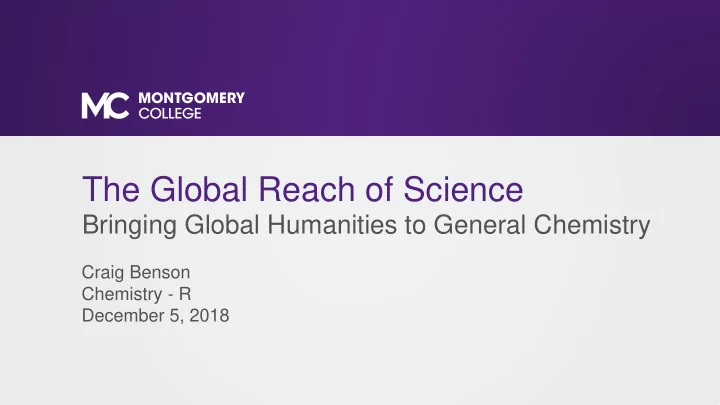

The Global Reach of Science Bringing Global Humanities to General Chemistry Craig Benson Chemistry - R December 5, 2018
Why Chemistry? Students in CHEM 131 tend to be narrowly focused on STEM fields or Pre-Med/Nursing. There are frequently International students, but seemingly at rates lower than the overall population of the College. There is very little opportunity in any of their classes to take a “big picture” look at the responsibilities they may have in a future career as a scientist. Global Humanities content, especially in an introductory course, can guide the rest of their studies.
Why not Chemistry? CHEM 131 is a lot of work for the students (6 credits including the mandatory laboratory) and is very content-heavy: Analyze and solve various problems that include Identify chemical and physical properties techniques such as filtration, collection of a combination of concepts from various gases, precipitation, weighing, and titration chapters Locate safety equipment and work safely in the laboratory Use dimensional analysis as a technique for Apply chemical principles to explain results solving problems and report the answer with the Make observations, collect and interpret data, appropriate number of significant figures Calculate the magnitude and direction of heat and do calculations flow for physical and chemical changes Use the Periodic table to predict relative Name and write symbols for elements, ions, and properties of elements and formulas of Demonstrate proper waste disposal compounds compounds, formula masses, electron configuration, and periodic trends Describe the chemical bonding between atoms Predict the qualitative behavior of gases, on the basis of atomic structure liquids, solids, and solutions Use types of chemical bonding and Lewis dot structures to predict the geometry, polarity, and properties of compounds Describe the major components of the atom and Predict the quantitative behavior of gases and their location in the atom. solutions Write balanced molecular, ionic, and net ionic equations and predict the products of various Determine solution concentrations and calculate Predict the types of intramolecular forces within types of reactions. the amounts of materials involved in solution a substance and intermolecular forces between reactions substances and in solution Do mole and stoichiometry calculations Successfully use chemistry laboratory
Where does it fit? (Some) discussion sections (25-50 min/week) Week 1 Haber Week 9 Thermochemistry Week 2 Dimensional Analysis Week 10 Heating the atmosphere Week 3 Nomenclature Week 11 Exam Week 4 Exam Week 12 Hydrogen economy Week 5 Study Skills Week 13 Everything Change Week 6 Carbon tax Week 14 Exam Week 7 Exam Week 15 Innovations Lab Week 8 Carbon emissions
Global Humanities Integration Global content will replace in-class worksheets currently used to reinforce lecture material. New worksheets will fit around a theme of Global Climate Change, and will include reflection questions on their responsibilities as scientists, with class discussions. Example calculation: The average annual energy use for a single family home in the United States is 10,399 kWh. The heat of formation of carbon dioxide is -393.5 kJ/mol. Assuming a power plant efficiency of 20%, what mass of CO 2 is produced by the average single family home in a year? Example reflection: Given the global emissions of CO 2 , do you think that an American household has a greater or lesser carbon footprint than the global average? In what ways can our energy use affect those in other nations?
Example Global Humanities Assignment Includes Haber short film Viewing of short biopic Haber , about the “father of chemical warfare.” Example discussion question: An actual quote that the film used is: "During peace time a scientist belongs to the World, but during war time he belongs to his country." What do you suppose he means by this? Does the quote mean something different to you? Are there global consequences to belonging to only a single country?
Global Humanities Learning Objectives Upon completing this internationalized module, students will be able to: Identify global effects of carbon emissions. Appraise one’s own actions in the context of global climate change. Evaluate the responsibilities of scientists in a global society.
Thank you Thank you all for your time and attention. Thank you to the MVOC Fellows for the excellent discussions, insight, and advice. Many thanks especially to Rita, Dre, Angela, and the GHI for the guidance and opportunity.
Recommend
More recommend